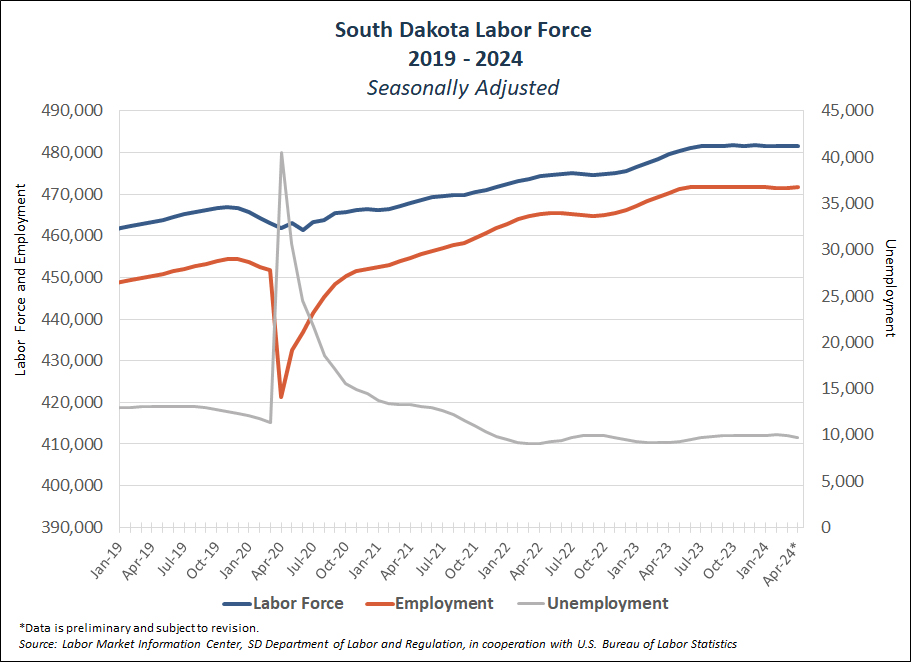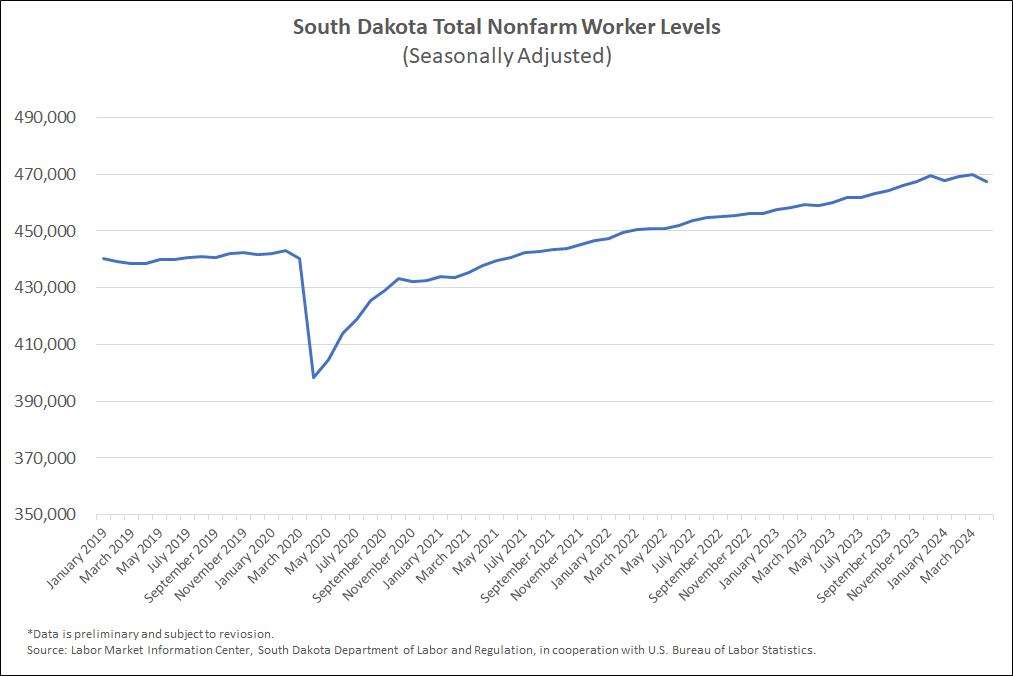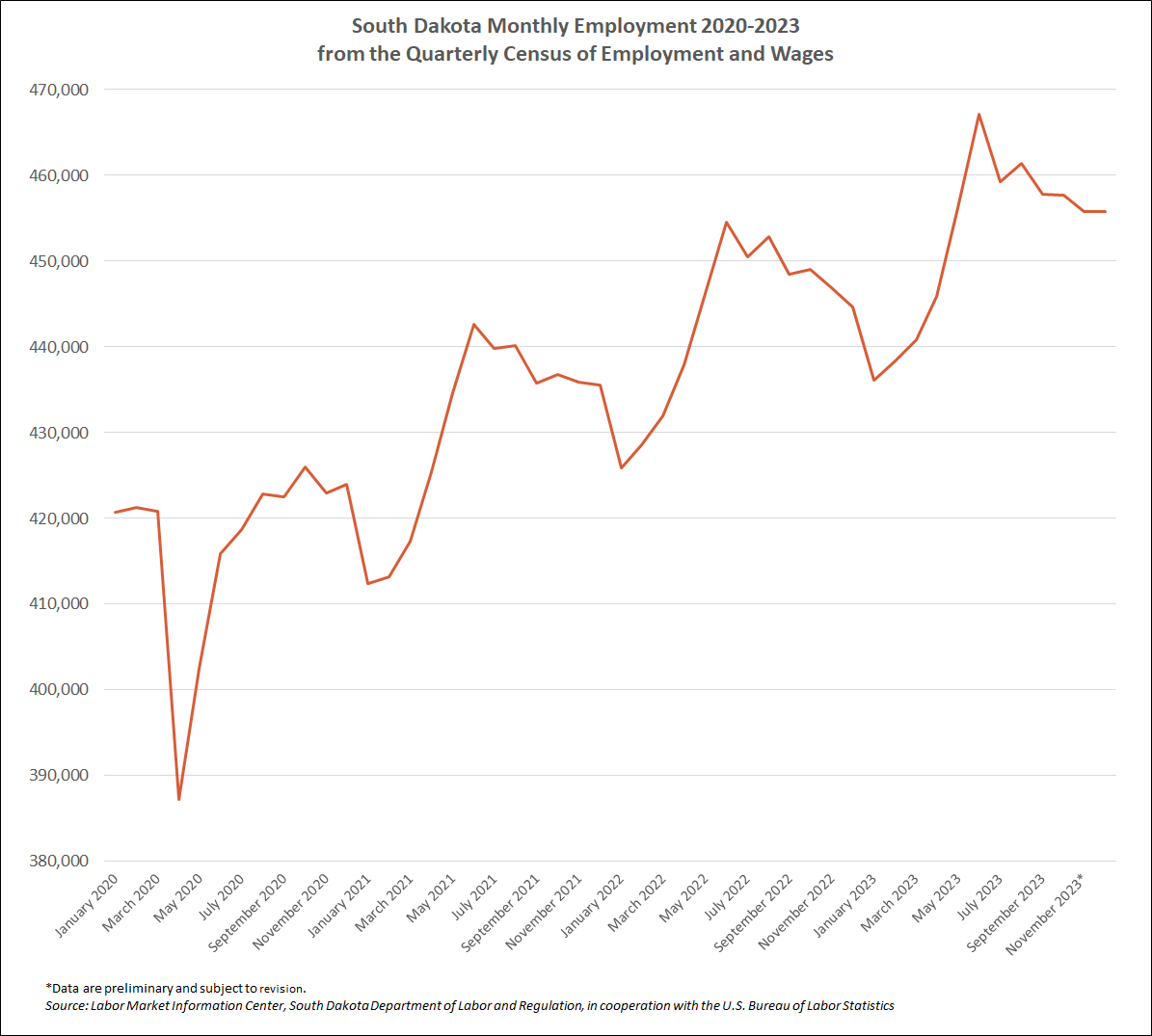- Home to LMIC
- Virtual Labor Market Data System
- Career Exploration & Planning
- Consumer Price Index
- Demographics
- Economic Snapshot
- Employee Benefits
- Employment Projections
- Labor Force & Unemployment
- Labor Supply
- Overview of the Current Labor Market
- Surveys We Conduct
- Wages & Income
- Workers by Industry
- Tools & Resources
- Publications
- References
- What's New
- Can't Find It?
South Dakota e-Labor Bulletin
May 2024
South Dakota's economic post-pandemic pulse
You may remember the Pandemic Picture we published during the COVID-19 pandemic, providing a monthly update on the health of the labor market in light of the pandemic’s impacts. We used three workforce data sets as indicators of the impact on the labor market:
- Labor force data (total workforce, employment, unemployment, and the unemployment rate)
- Worker levels by industry (nonfarm wage and salaried worker levels)
- Quarterly Census of Employment and Wages (QCEW)
It was April 2020 when these widely watched labor market data sets first showed the impacts of the pandemic. Although the pandemic struck in February 2020, both labor force and nonfarm worker data sets use a reference week including the 12th of the month. In other words, the estimates for the month are based on employment status during the week of the 12th. So, by the time April estimates were available, those comparisons started providing some indication of COVID’s impact on South Dakota employment levels. While many employers had been taking precautionary measures and reducing workers’ hours since the pandemic began (some as early as the week of March 12), the impact on employment levels of actions such as closures and layoffs was not comprehensively reflected until the week of April 12.
Since April 2024 data is now available for two of the three data sets above, we thought it would be interesting to see how South Dakota’s labor market has fared post-pandemic over the longer term.
Labor Force
South Dakota’s seasonally adjusted labor force had been steadily increasing before the COVID-19 pandemic caused the growth to stall. After bottoming out at 461,900 in April 2020, the labor force level was a bit erratic to June 2020. But since June 2020, the labor force has returned to its pre-pandemic smoother growth trend. Although the rate of growth has slowed since July 2023, the overall trend has still been upward through the current April 2024 labor force estimates. South Dakota’s labor force (the employed plus the unemployed actively seeking work) is now 19,600 stronger (estimated at 481,500) than it was when the pandemic hit workforce levels hard in April 2020.
Seasonally adjusted employment in South Dakota experienced a sharp decline in April 2020 when the effects of the pandemic began to impact the labor market. Between March 2020 and April 2020, South Dakota’s employment decreased by 30,300 (6.7%). While dramatic by South Dakota standards, even this drop was considerably less than at the national level, where U.S. employment decreased by 14.3%. May 2020 employment estimates showed South Dakota had regained more than one-third (11,200) of the employment lost between March and April. Employment bounced back to pre-pandemic levels by November 2020, while U.S. employment took until November 2021 to reach that milestone. Employment estimates for April 2024 show there are 50,400 more South Dakotans employed than in April 2020.
The number of unemployed in South Dakota rose dramatically in April 2020 once the effects of the pandemic began to set in. The number of unemployed increased by 29,200 (258.3%) between March and April. By May 2020, the number of unemployed had decreased by 9,900, and by September 2021 it was back to the pre-pandemic level. National unemployment did not return to pre-pandemic numbers until the summer of 2022. South Dakota’s level of unemployed continued to decline throughout 2021 and has remained at very low levels.
South Dakota’s seasonally adjusted unemployment rate spiked from 2.4% in March 2020 to an unprecedented 8.8% in April 2020. The national rate shot up from 4.4% to 14.8% over the same time period. South Dakota’s rate declined quickly after the initial spike and was down to 3.1% by the end of 2020. It continued to go down through 2021 and has remained at record low levels. The April 2024 seasonally adjusted unemployment rate for South Dakota is 2.0%, while the current national rate is 3.9%.

Nonfarm Wage and Salaried Workers
Not only did nonfarm wage and salaried worker levels in South Dakota rebound fairly quickly to pre-pandemic levels (by September 2021), they soon surpassed those levels and grew faster than they had in the years before the pandemic. Let’s reflect over the past five years to see what transpired. We’ll use seasonally adjusted data to more clearly see economic impacts without having to consider seasonally impacted changes.
Let’s first set the labor market stage in which the pandemic entered. South Dakota’s nonfarm seasonally adjusted worker levels fluctuated throughout 2019, ultimately going from 440,200 workers in January 2019 to 441,800 workers in December 2019. Health Care and Social Assistance had the largest growth during this time, adding 1,100 workers from January 2019 to December 2019.

While 2020 started as a typical year with January worker levels, it quickly changed in April 2020 when worker levels significantly declined due to the COVID-19 pandemic. Please keep in mind the 12th of the month reference week mentioned above, which is used for the establishment survey on which nonfarm worker levels are based.
Even though establishments began altering their processes or closing temporarily in March 2020, April brought far more pronounced worker declines. The nonfarm wage and salaried worker level decreased 41,900 workers (9.5%) in just one month, dropping to 398,300 workers in April 2020. South Dakota establishments quickly altered their plans to help lower the spread of the virus. Many establishments held off on hiring because of all the unknowns surrounding the virus.
By May 2020, establishments started to slowly increase worker levels, with some opening after temporarily closing. Establishments increased options to provide services to the consumer, including offering virtual appointments, spreading out dining tables, and marking customer-used floor space to promote social distancing and reduce capacity when distance was not an option.
Growth continued into 2021 as establishments recouped workforce lost during the COVID-19 pandemic. By September 2021, the number of nonfarm workers had recovered to the point (443,400) where it was before the pandemic hit (443,100 in February 2020). Worker levels continued to climb through December 2021, reaching 446,700 workers.
Worker levels continued trending upward throughout 2022 and 2023. Worker levels increased 12,300 in 2022 and 9,700 in 2023. Increases in demand along with gains in population have contributed to this growth. The U.S. Census Bureau estimated South Dakota’s population at 919,318 in July 2023 compared to 909,869 in July 2022.
Worker levels declined in January 2024, dropping to 467,900. After taking that quick dip, worker levels changed course, jumping to 469,100 in February 2024. This trend continued into March 2024, reaching a new high of 470,000. Preliminary estimates show the total nonfarm wage and salaried worker levels dipped slightly in April 2024, dropping to 467,400. Even with that little dip, the current level of nonfarm worker levels still shows a healthy gain of more than 27,000 workers and a gain of more than 6% from the pre-pandemic high of 440,200 recorded in March 2020.
Quarterly Census of Employment and Wages
The Quarterly Census of Employment and Wages (QCEW) program publishes a quarterly count of establishments, employment, and wages reported by employers covering 98% of wage and salaried jobs. It is based largely on data provided by employers to the South Dakota Division of Reemployment Assistance which are liable for unemployment insurance tax in the state. Because of reporting timeframes and the data processing involved, there is about a five-month lag in the availability of QCEW data. So, while QCEW data is not yet available through April 2024 like the other two data sets used above, data is available through fourth quarter 2023 to add some insights to South Dakota's post-pandemic performance.
As expected, first quarter 2020 data did not reflect pandemic-related economic impacts on South Dakota industry employment. In fact, when comparing South Dakota QCEW employment data for the first quarter of 2020 to the first quarter of 2019, there was slight growth in early 2020. The COVID-19 pandemic’s measurable impacts on South Dakota began in March 2020, when employment dropped slightly to 420,863 from the February 2020 level of 421,268. Like in the labor force and nonfarm worker data sets discussed above, the lowest point for QCEW employment was in April when employment dipped to 387,234.
QCEW data, too, indicates South Dakota’s rebound from the pandemic was fairly quick. The rebound began in May 2020, with a strong boost of 15,260 workers added back to payrolls. The increase in worker levels continued throughout 2020, with employment reaching a historical high of 426,022 in October. Employment levels ended the year at 423,927 in December.

During 2021, South Dakota’s employment continued to grow. From June 2020 to June 2021, employment grew 6.4% to 442,633. The 6.4% increase was higher than normal due to pandemic recovery. Worker levels decreased during the winter months of 2021 to 435,502 in December. The decrease in employment is normal for South Dakota due to seasonal factors.
Over the last two years, employment growth has been stable and relatively higher compared to years before the pandemic. From June 2021 to June 2022, employment increased 2.7% to 454,598. From June 2022 to June 2023, employment increased 2.8% to an all-time monthly high of 467,103.
To wrap up discussion on the COVID-19 pandemic’s impact on South Dakota’s QCEW employment data, worker levels only decreased for two months during 2020. Employment growth began shortly after and continued for the following three years. Looking back on worker levels before the pandemic, average employment in the fourth quarter of 2019 was 432,037. Four years later, in the fourth quarter of 2023 (most recent data available), average employment was 456,425 (5.6% increase). Preliminary first quarter 2024 QCEW data indicates this upward trend will likely continue this year.

Summary
The workforce data sets discussed above show our labor market recovered quickly and did not see the severe impacts of the pandemic other areas saw over that time. The data also indicate not only did South Dakota recover quickly but returned to and even surpassed rates of growth before the pandemic hit. Perhaps the energy of the recovery process was the impetus for even greater growth.
South Dakota was one of seven states that did not issue stay-at-home orders during the COVID-19 pandemic and the only one that did not require any businesses to close during the pandemic. The concept of our less populous state naturally offering greater social distancing during the pandemic caught the attention of people living elsewhere. That piqued interest led to their discovery of many other benefits of living here, aided further by an effective nationwide workforce recruitment campaign. The attention we received as being “open for business” during the pandemic, coupled with our ongoing positive business environment, appealed to entrepreneurs and businesses elsewhere. Only time will tell for sure, but the horizon seems to be bright for South Dakota’s continued strength and economic growth after surviving only a brief setback dealt by the pandemic.
